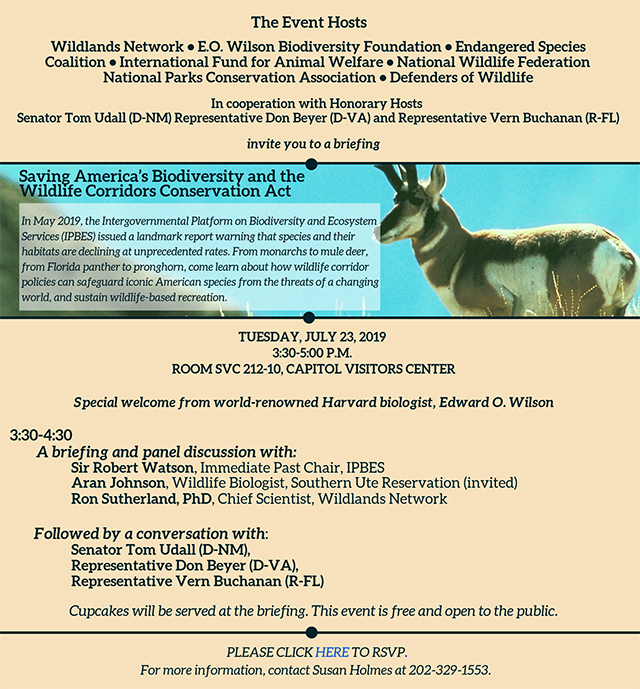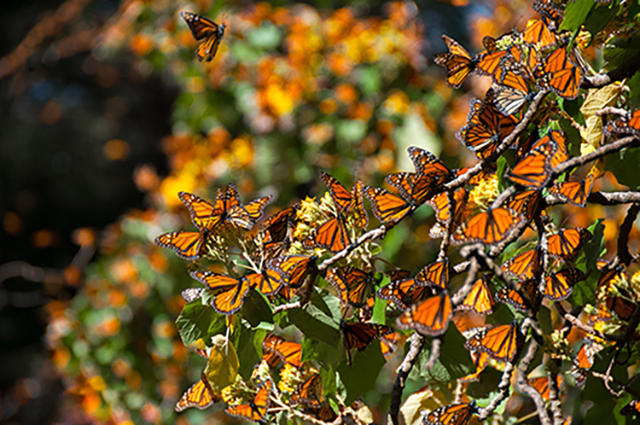

WILDLIFE CORRIDORS CONSERVATION ACT OF 2019 INTRODUCED IN CONGRESS WITH BI-PARTISAN SUPPORT FOLLOWING UN REPORT ON GLOBAL BIODIVERSITY CRISIS
WASHINGTON, D.C. (May 16, 2019) — Marking the most significant step toward national wildlife conservation in decades, the Wildlife Corridors Conservation Act of 2019 was introduced today in both houses of Congress. Led by Sen. Tom Udall (D-NM), the bill was co-sponsored in the Senate by Richard Blumenthal (D-CT), Cory Booker (D-NJ), Kamala Harris (D-CA), Jeff Merkley (D-OR), Bernie Sanders (D-VT), Jon Tester (D-MT), Sheldon Whitehouse (D-RI), and Ron Wyden (D-OR). The bill was introduced in the House of Representatives by Congressmen Don Beyer (D-VA) and Vern Buchanan (R-FL).


This bi-partisan introduction comes just weeks after the United Nations released a harrowing report detailing the threats facing global biodiversity, including wildlife native to America. If passed, the Act will restore habitat and protect America’s native wildlife by establishing a National Wildlife Corridors Program that facilitates the designation of wildlife corridors on federal lands and provides grants to maintain wildlife corridors on non-federal lands. Fragmentation of wildlife habitat has been identified as a significant threat to wildlife across America.
“The Wildlife Corridors Conservation Act would provide the most important step of any single piece of legislation at the present time in enlarging the nations protected areas and thereby saving large swaths of America’s wildlife and other fauna and flora, especially in this critical time of climate change and shifting locations of the original environments in which a large part of biodiversity has existed.” – E.O. Wilson
“Wildlands Network thanks Sen. Udall and Reps. Beyer and Buchanan for their leadership to protecting America’s Wildlife,” said Susan Holmes, Federal Policy Director, Wildlands Network. “From elk to monarch butterflies, America’s wildlife needs to move across the landscape to survive. The Wildlife Corridors Conservation Act will reconnect important landscapes and protect species in the face of climate change and development. The UN report makes it clear – we cannot wait any longer to take action. The Wildlife Corridors Conservation Act is the most significant national proposal to protect wildlife we have seen in decades and gives us hope that we are not too late to protect the wildlife we love and need.”
The Act grants authority to key federal agencies to create a National Wildlife Corridor system on federal public land and creates a Wildlife Movement Grant Program to incentivize the protection of wildlife corridors by state and tribal agencies, as well as interested private landowners, on non-federal lands. It also establishes Regional Wildlife Movement Councils and a National Coordination Committee to identify, prioritize and fund on-the-ground projects supported by state agencies, tribes and local stakeholders.
“America’s wilderness has sustained our treasured native fish, wildlife and plant species for hundreds of years, but this vital part of our national heritage is in jeopardy,” said Sen. Udall. “The habitats and migration routes that our wildlife rely on to move and thrive are under increasing pressures, and our precious biodiversity along with it. In New Mexico, our millions of acres of public lands are home to thousands of iconic species—from the desert bighorns to whooping cranes to Gila trout—that could vanish if we fail to take bold action. These species are essential to our rich natural inheritance and agricultural and economic success, and are an important legacy to pass on to our children. By designating corridors that would connect these vital habitats to one another, we can ensure the survival of some of our most iconic species, from the monarch butterfly to the Louisiana black bear, and preserve our precious wildlife for future generations to come.”
“With roughly one in five animal and plant species in the U.S. at risk of extinction due to habitat loss and fragmentation, one of the simplest yet most effective things we can do is to provide them ample opportunity to move across lands and waters,” said Rep. Beyer. “The U.N. report on accelerating extinctions makes it clear that the window for action to protect the planet’s biodiversity is closing. We badly need to pass the Wildlife Corridors Conservation Act.”
“Protecting wildlife and promoting biodiversity are of critical importance in light of a new study warning that one million species are facing extinction,” said Rep. Buchanan. It’s time for Congress to help restore threatened wildlife populations and safeguard our nation’s lands and waters. We don’t get a second chance once a species becomes extinct.”
Wildlife corridors are critically important habitat areas that allow animals to move between areas of habitat, facilitating migration, range expansion, and mating. Protecting wildlife corridors also increases potential resiliency of animal populations in the face of changing landscapes and climate. The bill is supported by nationally recognized scientists, including Harvard’s Dr. E.O. Wilson, and over 220 prominent NGOs nationwide.
“The Wildlife Corridors Conservation Act would provide the most important step of any single piece of legislation at the present time in enlarging the nations protected areas and thereby saving large swaths of America’s wildlife and other fauna and flora, especially in this critical time of climate change and shifting locations of the original environments in which a large part of biodiversity has existed,” renowned biologist E.O. Wilson said of the bill.
“Defenders of Wildlife commends Sen. Udall, Rep. Beyer and Rep. Buchanan for their leadership in protecting America’s wildlife. Confronting a rapidly changing climate and pressure from human development, wildlife need the freedom to move across our nation’s landscape. The legislation introduced today draws all Americans into the effort to support wildlife by mapping the corridors and connecting landscapes that they need to survive and thrive,” said Jamie Rappaport Clark, president and CEO of Defenders of Wildlife.
The bill would also improve wildlife-related recreational opportunities and has received support from major outdoor brands, including Patagonia and Osprey Packs.
“We are still in business today because we fight for the protection of our public lands and waters and the biodiversity that they support,” stated Alison Huyett, Patagonia’s Environmental Campaigns Manager. “We are proud to stand behind this critical legislation that will help protect and restore America’s native wildlife and create more resilient landscapes.”
Wildlife species in need of protected corridors include the pronghorn antelope, an important game species in the Southwest, whose survival depends upon the ability to migrate seasonally. Even small insects like the monarch butterfly need protected corridors to migrate up to 3,000 miles. It can take 3-4 generations to complete a full migration, and without protected places along the flyway for them to rest and reproduce, the species could be lost entirely.
“The recent UN report makes it crystal clear that America needs more tools to protect plants and animals,” stated Leda Huta, Executive Director of the Endangered Species Coalition. “We have ignored biodiversity for too long and at our own peril. If we want to recover declining plant and animal populations–and reap the benefits of biodiversity for the health and safety of humans–wildlife corridors are a no-brainer.”
“The Wildlife Corridors Conservation Act will provide a crucial lifeline for many of America’s native species,” stated Rob Ament, Senior Conservationist at the Center for Large Landscape Conservation, “so they can safely move across America’s landscapes to meet their daily, seasonal and lifetime needs.”
“The National Parks Conservation Association commends the legislation for the benefits that it could provide to wildlife that travel beyond park boundaries such as Los Angeles mountain lions in Santa Monica Mountains National Recreation Area,” said Theresa Pierno, President and CEO of the National Parks Conservation Association. “The legislation would build upon the success of the Path of the Pronghorn outside of Grand Teton, America’s first nationally protected wildlife corridor which serves as a testimony to the success of community, state and federal collaboration.”
Background:
Protection of wildlife corridors is a conservation goal with bipartisan support around the country. In the last decade, the Western Governors’ Association and the New England Governors and Canadian Premiers both adopted wildlife corridor protection measures. In 2018, Secretary of the Interior Ryan Zinke issued Secretarial Order 3362, which would improve “habitat quality in Western big-game winter range and migration corridors.” In addition, both red and blue states such as New Hampshire, Wyoming, New Mexico and California have recently passed measures to protect wildlife corridors.
Additional resources:
Wildlands Network created a fact sheet for the Wildlife Corridors Conservation Act, as well as facts sheets for potential impacts of the bill on specific species, including grizzly bears, monarch butterflies, Florida panthers and pronghorns.

